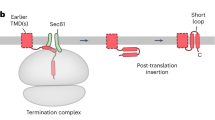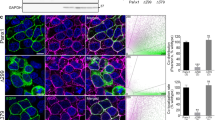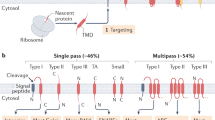Abstract
Membrane proteins represent approximately 30% of the proteome in both prokaryotes and eukaryotes1. The spatial localization of membrane-bound proteins is often determined by specific sequence motifs2 that may be regulated in response to physiological changes, such as protein interactions3 and receptor signalling4. Identification of signalling motifs is therefore important for understanding membrane protein expression, function and transport mechanisms. We report a genetic isolation of novel motifs that confer surface expression. Further characterization showed that SWTY, one class of these isolated motifs with homology to previously reported forward transport motifs5, has the ability to both override the RKR endoplasmic reticulum localization signal and potentiate steady-state surface expression. The genetically isolated SWTY motif is functionally interchangeable with a known motif in cardiac potassium channels and an identified motif in an HIV coreceptor, and operates by recruiting 14-3-3 proteins. This study expands the repertoire of and enables a screening method for membrane trafficking signals.
This is a preview of subscription content, access via your institution
Access options
Subscribe to this journal
Receive 12 print issues and online access
$209.00 per year
only $17.42 per issue
Buy this article
- Purchase on Springer Link
- Instant access to full article PDF
Prices may be subject to local taxes which are calculated during checkout





Similar content being viewed by others
References
Wallin, E. & von Heijne, G. Genome-wide analysis of integral membrane proteins from eubacterial, archaean, and eukaryotic organisms. Protein Sci. 7, 1029–1038 (1998).
Bonifacino, J. S. & Glick, B. S. The mechanisms of vesicle budding and fusion. Cell 116, 153–166 (2004).
Zerangue, N., Schwappach, B., Jan, Y. N. & Jan, L. Y. A new ER trafficking signal regulates the subunit stoichiometry of plasma membrane K(ATP) channels. Neuron 22, 537–548 (1999).
Viard, P. et al. PI3K promotes voltage-dependent calcium channel trafficking to the plasma membrane. Nature Neurosci. 7, 939–946 (2004).
O'Kelly, I., Butler, M. H., Zilberberg, N. & Goldstein, S. A. Forward transport. 14-3-3 binding overcomes retention in endoplasmic reticulum by dibasic signals. Cell 111, 577–588 (2002).
Schwappach, B., Zerangue, N., Jan, Y. N. & Jan, L. Y. Molecular basis for K(ATP) assembly: transmembrane interactions mediate association of a K+ channel with an ABC transporter. Neuron 26, 155–167 (2000).
Shikano, S. & Li, M. Membrane receptor trafficking: Evidence of proximal and distal zones conferred by two independent endoplasmic reticulum localization signals. Proc. Natl Acad. Sci. USA 100, 5783–5788 (2003).
Nishimura, N. & Balch, W. E. A di-acidic signal required for selective export from the endoplasmic reticulum. Science 277, 556–558 (1997).
Sevier, C. S., Weisz, O. A., Davis, M. & Machamer, C. E. Efficient export of the vesicular stomatitis virus G protein from the endoplasmic reticulum requires a signal in the cytoplasmic tail that includes both tyrosine-based and di-acidic motifs. Mol. Biol. Cell 11, 13–22 (2000).
Ma, D. et al. Role of ER export signals in controlling surface potassium channel numbers. Science 291, 316–319 (2001).
Nilsson, T., Jackson, M. & Peterson, P. A. Short cytoplasmic sequences serve as retention signals for transmembrane proteins in the endoplasmic reticulum. Cell 58, 707–718 (1989).
Tang, W. et al. Functional expression of a vertebrate inwardly rectifying K+ channel in yeast. Mol. Biol. Cell 6, 1231–1240 (1995).
Chung, J. J., Shikano, S., Hanyu, Y. & Li, M. Functional diversity of protein C-termini: more than zipcoding? Trends Cell Biol. 12, 146–150 (2002).
Li, M., Unwin, N., Stauffer, K. A., Jan, Y. N. & Jan, L. Y. Images of purified Shaker potassium channels. Curr. Biol. 4, 110–115 (1994).
Moore, B. & Perez, V. J. Specific Acidic Proteins of the Nervous System (ed. Carlson, F. D.) 343–359 (Prentice-Hall, Englewood Cliffs, NJ, 1967).
Wang, B. et al. Isolation of high-affinity peptide antagonists of 14-3-3 proteins by phage display. Biochemistry 38, 12499–12504 (1999).
Sun, H., Shikano, S., Xiong, Q. & Li, M. Function recovery after chemobleaching (FRAC): evidence for activity silent membrane receptors on cell surface. Proc. Natl Acad. Sci. USA 101, 16964–16969 (2004).
Fu, H., Subramanian, R. R. & Masters, S. C. 14-3-3 proteins: structure, function, and regulation. Annu. Rev. Pharmacol. Toxicol. 40, 617–647 (2000).
Yaffe, M. B. How do 14-3-3 proteins work? — Gatekeeper phosphorylation and the molecular anvil hypothesis. FEBS Lett. 513, 53–57 (2002).
Ganguly, S. et al. Melatonin synthesis: 14-3-3-dependent activation and inhibition of arylalkylamine N-acetyltransferase mediated by phosphoserine-205. Proc. Natl Acad. Sci. USA 102, 1222–1227 (2005).
Lopes, C. M., Gallagher, P. G., Buck, M. E., Butler, M. H. & Goldstein, S. A. Proton block and voltage gating are potassium-dependent in the cardiac leak channel Kcnk3. J. Biol. Chem. 275, 16969–16978 (2000).
Maresca, M. et al. The virotoxin model of HIV-1 enteropathy: involvement of GPR15/Bob and galactosylceramide in the cytopathic effects induced by HIV-1 gp120 in the HT-29-D4 intestinal cell line. J. Biomed. Sci. 10, 156–166 (2003).
Wade-Evans, A. M., Russell, J., Jenkins, A. & Javan, C. Cloning and sequencing of cynomolgus macaque CCR3, GPR15, and STRL33: potential coreceptors for HIV type 1, HIV type 2, and SIV. AIDS Res. Hum. Retroviruses 17, 371–375 (2001).
Yuan, H., Michelsen, K. & Schwappach, B. 14-3-3 dimers probe the assembly status of multimeric membrane proteins. Curr. Biol. 13, 638–646 (2003).
Yaffe, M. B. et al. A motif-based profile scanning approach for genome-wide prediction of signaling pathways. Nature Biotechnol. 19, 348–353 (2001).
Dougherty, M. K. & Morrison, D. K. Unlocking the code of 14-3-3. J. Cell Sci. 117, 1875–1884 (2004).
Kagan, A., Melman, Y. F., Krumerman, A. & McDonald, T. V. 14-3-3 amplifies and prolongs adrenergic stimulation of HERG K+ channel activity. EMBO J. 21, 1889–1898 (2002).
Mossessova, E., Bickford, L. C. & Goldberg, J. SNARE selectivity of the COPII coat. Cell 114, 483–495 (2003).
Miller, E. A. et al. Multiple cargo binding sites on the COPII subunit Sec24p ensure capture of diverse membrane proteins into transport vesicles. Cell 114, 497–509 (2003).
Chung, J. J., Yang, H. & Li, M. Genome-wide analyses of carboxyl-terminal sequences. Mol. Cell. Proteomics 2, 173–181 (2003).
Coblitz, B. et al. Carboxyl-terminal recognition by 14-3-3 proteins for surface expression of membrane receptors. J. Biol. Chem. (in the press).
Ma, D. et al. Diverse trafficking patterns due to multiple traffic motifs in G protein-activated inwardly rectifying potassium channels from brain and heart. Neuron 33, 715–729 (2002).
Acknowledgements
We thank L. Jan for providing Kir2.1 and Kir6.2 cDNAs, S. Goldstein for KCNK3 cDNA, H. Fu for providing 14-3-3 constructs and many insightful discussions, R. Doms for GPR15 cDNA, M. Spieker and R. Sheng for helping with DNA recovery and sequencing, and the members of the Li laboratory and C. Montell and C. Machamer for helpful comments on this manuscript. We are indebted to S. Goldstein for his invaluable advice on this manuscript. The work is supported by grants from the National Institutes of Health (GM70959 and NS33324 to M.L.); pre-doctoral (to B.C.) and postdoctoral (to H.S.) fellowship awards from the American Heart Association.
Author information
Authors and Affiliations
Corresponding author
Ethics declarations
Competing interests
The authors declare no competing financial interests.
Supplementary information
Supplementary Information
Supplementary figures S1 and S2 (PDF 113 kb)
Rights and permissions
About this article
Cite this article
Shikano, S., Coblitz, B., Sun, H. et al. Genetic isolation of transport signals directing cell surface expression. Nat Cell Biol 7, 985–992 (2005). https://doi.org/10.1038/ncb1297
Received:
Accepted:
Published:
Issue Date:
DOI: https://doi.org/10.1038/ncb1297
This article is cited by
-
Identification of Receptor Ligands in Apo B100 Reveals Potential Functional Domains
The Protein Journal (2018)
-
Wnt5a induces ROR1 to associate with 14-3-3ζ for enhanced chemotaxis and proliferation of chronic lymphocytic leukemia cells
Leukemia (2017)
-
The role of protein–protein interactions in the intracellular traffic of the potassium channels TASK-1 and TASK-3
Pflügers Archiv - European Journal of Physiology (2015)
-
14-3-3s are potential biomarkers for HIV-related neurodegeneration
Journal of NeuroVirology (2012)
-
The central proline rich region of POB1/REPS2 plays a regulatory role in epidermal growth factor receptor endocytosis by binding to 14-3-3 and SH3 domain-containing proteins
BMC Biochemistry (2008)



